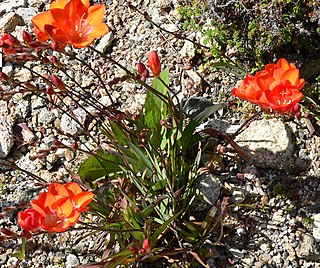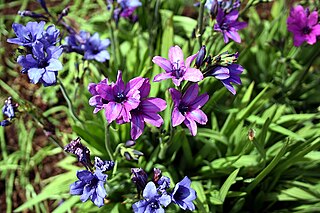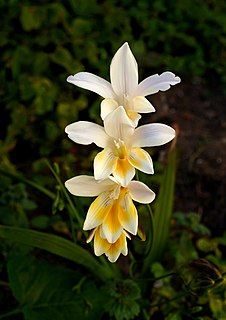A genus is a taxonomic rank used in the biological classification of living and fossil organisms, as well as viruses, in biology. In the hierarchy of biological classification, genus comes above species and below family. In binomial nomenclature, the genus name forms the first part of the binomial species name for each species within the genus.
Binomial nomenclature, also called binominal nomenclature or binary nomenclature, is a formal system of naming species of living things by giving each a name composed of two parts, both of which use Latin grammatical forms, although they can be based on words from other languages. Such a name is called a binomial name, a binomen, binominal name or a scientific name; more informally it is also called a Latin name.

A corm, bulbo-tuber, or bulbotuber is a short, vertical, swollen underground plant stem that serves as a storage organ that some plants use to survive winter or other adverse conditions such as summer drought and heat (perennation).

Iridaceae is a family of plants in order Asparagales, taking its name from the irises, meaning rainbow, referring to its many colours. There are 66 accepted genera with a total of c. 2244 species worldwide. It includes a number of other well known cultivated plants, such as freesias, gladioli and crocuses.

A botanical name is a formal scientific name conforming to the International Code of Nomenclature for algae, fungi, and plants (ICN) and, if it concerns a plant cultigen, the additional cultivar or Group epithets must conform to the International Code of Nomenclature for Cultivated Plants (ICNCP). The code of nomenclature covers "all organisms traditionally treated as algae, fungi, or plants, whether fossil or non-fossil, including blue-green algae (Cyanobacteria), chytrids, oomycetes, slime moulds and photosynthetic protists with their taxonomically related non-photosynthetic groups ."
Jiro Matsumoto is a Japanese manga artist most known for his work on Freesia. Much of his manga is explicit in nature, frequently containing copious amounts of sex and violence.
Japonica refers to things related to Japan.

Tritonia is a genus of flowering plants in the iris family first described as a genus in 1802. They are naturally distributed across southern Africa, with a high concentration of species in Cape Province of western South Africa. The genus is closely related to the genus Ixia.

Monthly Ikki was a monthly seinen manga magazine published by Shogakukan. It tended to specialize in underground or alternative manga, but has had its share of major hits as well. The magazine started has a spin-off of Shogakukan's Big Comic Spirits in 2000 and became a standalone monthly magazine in 2003. Notably, both Bokurano and Ride Back have received anime adaptations. In 2009 Viz Media launched an online English version of Ikki named Sigikki. The website serializes various titles from Ikki online and then when a title proves to be popular it receives publication in graphic novel form. The manga magazine suspended publication on 25 September 2014.

Babiana stricta is a species of flowering plant in the family Iridaceae, native to Cape Province, South Africa and naturalized in Australia. Growing 10–30 cm (4–12 in) tall by 5 cm (2 in) broad, it is a cormous perennial with hairy leaves 4–12 cm (2–5 in) long. The leaves show linear venation.

Crocoideae is one of the major subfamilies in the family Iridaceae.
{{Taxobox |name =Xenoscapa |image = |image_caption = |regnum =Plantae | unranked_divisio =Angiosperms | unranked_classis =Monocots |ordo =Asparagales |familia =Iridaceae |subfamilia =Crocoideae |tribus =Freesieae |genus =Xenoscapa |genus_authority =(Goldblatt) Goldblatt & J.C.Manning. |type_species =Xenoscapa fistulosa |type_species_authority =(Sprengel ex Klatt) Goldblatt & J.C. Manning |subdivision_ranks =Species |subdivision = }}

Aspiviridae, formerly Ophioviridae is a family of viruses characterized by an elongated and highly filamentous and flexible nucleocapsid with helical symmetry. It is a monotypic taxon containing only one genus, Ophiovirus. Aspiviridae is also the only family in the order Serpentovirales, which in turn is the only order in the class Milneviricetes.
Thrips simplex is a species of insect in the genus Thrips in the order Thysanoptera. It is commonly known as the gladiolus thrips and infests gladiolus plants as well as various other monocotyledonous plants such as lilies, irises and freesias.
This page is based on this
Wikipedia article Text is available under the
CC BY-SA 4.0 license; additional terms may apply.
Images, videos and audio are available under their respective licenses.











